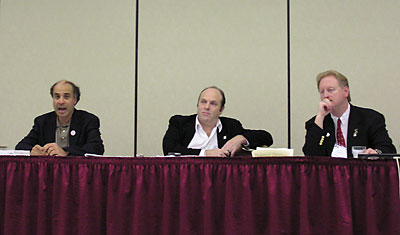The great launch debateby Jeff Foust
|
| “It’s not about destinations, it’s about settlement,” Tumlinson said. |
Greg Allison of the NSS agreed, seeing the vision as an opportunity to get NASA out of LEO and make it into more of a research and development agency rather than an operator. He noted that the bureaucracy of NASA would weigh down any government-led efforts to develop a new launch vehicle. “We don’t need another bureaucratic program like the shuttle that keeps commercial ventures from developing launch services,” he said. “We can’t get to space with that attitude.”
Mars Society president Bob Zubrin, however, presented a narrower focus. He recounted a meeting at NASA’s Marshall Space Flight Center in the early 1960s where engineers were debating the potential mission architectures for sending humans to the Moon. The debate continued, he said, until finally one engineer asked, “Do we really want to go to the Moon or don’t we?” With Kennedy’s deadline adding schedule pressure to the project, NASA eventually selected lunar orbit rendezvous, a straightforward approach that required no facilities or assembly in Earth orbit.
NASA and the American public is facing the same question now, Zubrin noted. The simplest way to do this, he concluded, is to build some kind of new heavy-lift launch vehicle, although he expressed no preference to any particular design. Without such a vehicle, he said, missions to the Moon and Mars will have to be assembled on orbit from multiple launches, adding to the difficulty of such a mission. “If you want to build a lunar base,” he said, “you cannot do it based on having to build a space station each and every time you want to go to the Moon.”
A new heavy-lift vehicle, he added, is no obstacle to settlement. “The purpose of this [vision] is to establish humanity on the Moon and Mars,” he said. “The fastest and cheapest way to do that is to develop a heavy-lift launch vehicle that can do the initial missions and the follow-up missions most efficiently.”
Launch costs and the role of the private sector
Zubrin estimated that a new heavy-lift vehicle would cost perhaps $4 billion to develop and $300 million per launch. He admitted that this was not an inexpensive proposition. “NASA cannot develop cheap access to orbit,” he said. “It can’t do it. NASA can, however, develop big access to orbit. It is within the competence of NASA to develop a big launch vehicle.”
Allison, however, believes that a heavy-lift vehicle would cost far more: perhaps $20 billion to develop and $1 billion per launch. “Worse yet, after spending $20 billion developing the thing, or something along those lines, it’s probably going to become the next X program and get shut down,” he added. “I don’t really know or believe that there’s the political resolve to see that program through.”
| “NASA cannot develop cheap access to orbit,” Zubrin said. “NASA can, however, develop big access to orbit.” |
Allison instead believes that the private sector needs to play a larger role. “Let NASA develop the Crew Exploration Vehicle, but mandate private launch service provisions,” he suggested. “The vision is about sustainability and reliability, and I think you get there for starters by using what we’ve got and let the private companies come up and replace those services with more reliable, lower cost systems in the future.”
Tumlinson agreed that there needs to be a wider range of alternatives for launch services, and that the private sector is best suited to providing those options. “The equivalent of building one giant national spaceship would be is if you took all the explorers, like Hudson and Columbus, and put them in one gigantic ship that would be allowed to go occasionally, if it was finished, to the New World and back.”
Even Zubrin sees a role for commercialized launch services in the vision, once heavy-lift vehicles have established bases on the Moon or Mars. “You throw the logistics manifest of those bases open to private launch companies. If they can deliver cargo to the Moon or to Mars, preferably at a low price, then by all means use them,” he said. “You now have hundreds, perhaps thousands of tons of cargo launched into Earth orbit every year. You now have the kind of market needed to mobilize private investment in launch vehicle companies.”
Debate outcome
At the end of the debate the audience was asked to vote for the debater whose views they most agreed with. The results were close: 32 voted for Zubrin, 26 voted for Tumlinson, and 4 for Allison. However, since Tumlinson and Allison held essentially the same viewpoint—promoting commercial alternatives to a government-developed heavy-lift vehicle—the outcome was very nearly a tie between that viewpoint and Zubrin’s preference for a new government-funded heavy-lift launcher.
The outcome suggests that there will be no easy answer to the heavy-lift question. The Aldridge Commission suggested that a heavy-lift vehicle was necessary, calling it an “enabling technology” for implementing the vision, yet also suggested that heavy-lift vehicles might be developed commercially instead of by NASA. The space agency, meanwhile, is crunching the numbers on implementing the vision, and is apparently looking for ways to avoid developing a clean sheet heavy-lifter, seeing instead if it’s possible to upgrade an EELV to meet any heavy-lift requirements. With the fate of the vision still very much uncertain, any decision regarding heavy-lift launch capability may play a critical role in its ultimate success or failure.
